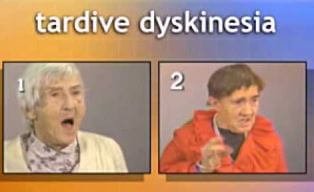Tardive Dyskinesia
What is Tardive Dyskinesia?
Tardive term is used when any medical condition is arises at late phase or after a prolonged condition. In tardive dyskinesia, the reported symptoms build up and continue after a prolong use of the psychiatric or gastrointestinal drugs which block dopamine receptor and even after discontinuation of the medication.
Prolong use of certain dopamine blocking drugs able to change the biochemical balance and raise abnormalities in the area of the brain, which is responsible for controlling the neuro- muscular movement.

Causes
The first incident was reported with metoclopramide (Reglan) drug in United State. After the incidence the continuous research revealed that tardive dyskinesia developed due to impede production of the dopamine which may arise due to damage of the dopamine production system. Dopamine is a neurotransmitter present at the brain, which can control movement and emotion.
Blocking of dopamine receptor activity, dopamine remains in the synaptic region where impulse transmission takes place for a prolong period of time and after that it destroyed. A lack of dopamine activity causes involuntary movement and in long run untreated condition may cause Parkinson’s disease.
At initial stage of tardive dyskinesia, may certain patients experience euphoric symptom due to over dopaminergic activity at the synaptic region. Medications which can develop tardive dyskinesia act as a dopamine receptor blocker and hinder the deliverance of electro-chemical signalling for neuro-transmission from the brain to other parts of the body and resultant uncontrollable muscular movement, including tardive dyskinesia.
Different traditional neuroleptic drugs used for psychotic patients cause tardive dyskinesia. The onset of this disorder occurs after a prolong use of the drug, maybe after several months or years. Some case reports provide evidence after six weeks of using such drugs causes onset of tardive dyskinesia.
The enlisted antipsychotic drugs which can develop tardive dyskinesia are as follows:
- Haloperidol
- Chlorpromazine
- Trifluoperazine
- Fluphenazine
Other than these, anti-depressants, anti-epileptic, antimalarial drugs also cause tardive dyskinesia, which include Ethosuximide, Flunarizine, Phenytoin, Chloroquine, Prochlorperazine, etc.
Novel antipsychotic drugs are less commonly caused tardive dyskinesia, but not fully safe.
Symptoms
Facial muscles are mainly affected by tardive dyskinesia and less frequently at the toes, fingers and limbs. The following symptoms are common with tardive dyskinesia.
- Facial muscles got spontaneous, recurring tic-like throbbing sensation.
- Frequent eye blinking
- Finger and toe shaking
- Jaw wavering
- Continuous masticating
- Tongue protuberance
- Prominent but slow curving neck and trunk movement.
- Limbs and hip are less affected, but some individual reported involuntary movement are also present in these areas.
Diagnosis
The above mentioned facial and other parts of the body involuntarily moved due to the influence of neuroleptic disorder. Affected persons may unaware of the uncontrollable movement which may notice by the caregiver of the patient. It is suggested that do not ignore such type of movement, consult with doctors immediately.
Physical Examination
Doctors usually closely monitor and examine the physical movement which is specifically characterized in tardive dyskinesia such as:
- Orofacial hyperkinesias which involved unintentional, cyclic, and stereotyped facial expression with bending or protuberance of the tongue.
- Writing habit is changed and time-consuming, snakelike writing
- Repetitive flexion and extension movements of the fingers or wrists
- Patient become restless and want to move
- Patients become distress which can be ranged from mild to severe.
Above mention physical sign and symptom analysis are the prime to detect tardive dyskinesia.
For confirmation, doctors prescribed specific diagnostic tests which include laboratory tests and imaging tools.
Laboratory tests
- Conduction of urine copper collection provides atypical result,
- Abnormality occurs in copper transporter gene
- Conduction of liver function tests and liver transaminases may provide abnormal result.
- For evaluation of tardive blepharospasm, serum biochemical analysis, serum copper, serum calcium, serum ceruloplasmin, thyroid function tests, and syphilis serology is conducted.
Imaging tools
Different imaging tools such as CT scan, MRI, PET (positron emission tomography) test and SPECT (single-photon emission computed tomography) are utilized to detect the tardive dyskinesia.
- In some cases, doctors also prescribed to conduct electroencephalography (EEG).
- Usually CT scans, MRI reports are normal in case of tardive dyskinesia, but conduction of these tests helps to differentiate the disease from other similar types of syndrome such as Huntington disease.
- PET and SPECT may help differentiate tardive dyskinesia from globus pallidus and the precentral gyrus.
- To diagnose the neural damage at the left lenticular nucleus which is the specific characteristics of tardive dyskinesia, proton magnetic resonance spectroscopy is conducted.
Treatment
In most of the cases, withdrawing or restricting of causative medications help to control the involuntary movement of tardive dyskinesia, though sudden withdrawal is not also advisable for certain medicines.
Clinical trials provide the information about Botulinum toxin (Botox) injections are effective against uncontrollable movement occurs in tardive dyskinesia.
Another study conducted by van Harten et al reported that lithium has a preventive action against the progression of tardive dyskinesia.
References
- http://www.tardivedyskinesia.com/
- http://www.webmd.com/schizophrenia/tardive-dyskinesia
- http://emedicine.medscape.com/article/1151826-overview
- http://www.medicinenet.com/script/main/art.asp?articlekey=24146
- https://www.nlm.nih.gov/medlineplus/ency/article/000685.htm
